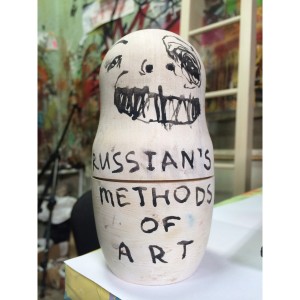For me, or rather for us – I’m talking about Bloch here, motors are very often strategies and ten years ago we had a very different set of strategies. In the early days these were strategies like attention economy, as in branding, provocation or irony. Everything had something to do with deconstruction, with distance and people from the outside. Strategies were seduction, manipulation. Today we are more open and affirmative. That could also be a strategy. To deny to know the outcome. It could also be a strategy to have a setting and to adjust it again and again and to go to the right and the left. You have to endure the openness. You have to be curious. You can create tools to invite. This can also be a new method or strategy. To let people continue to work on the material. To kick the ball into the game and see what happens. Will the ball shrink or grow? We get new income, when we invite people, curate and post produce. This is another concept, method or strategy within the project. Another method, in the past and the present, is to make systems clash together. On the one side we don’t really understand them. We bring things together that don’t actually belong together. In the best case we let these systems dance and see what happens. And then we distillate a film or a book or a product in the end or we just let the process speak for itself. The beginning is conceptional and then it’s a reaction. We rarely stood there with a white piece of paper and watched the line lead somewhere. We usually set some conceptional and strategic frames. For example: We want a hit parade and how do we get there now? We need a Co-Star, a professional video, a sound that is similar to the sound of hits and then we fulfill these propositions – self-fulfilling prophecy. With Bloch we can say that it will be that. It is an art work or a cultural work of art already and we set it on tour and see what happens. What the outcome is, what we can extract, where it will lead us. There is a frame that says, it will travel around the world, it will clash with different cultures or expand. But that’s it then! What the content is, what actually happens is out of our hands. Something, that could link the early, more deconstructive art works, with the present, more affirmative and open works, could be, that we make propositions which transform fictitious, non existent ideas, claims and inventions into a reality. In the early days we said: We are pop stars and this is our new hit and we are friends of Dieter Meier and we are in the hit parade and we made it into the hit parade. Project done. Succeeded. Good bye. But it was never the aim to become real pop stars. It’s the same with C-Files. We assume there is this gigantic Hollywood movie. We play the leading parts. It’s an entanglement between the foundation story and X-Files and a bit of fantasy is shuffled into it, paranormal, hoho! Everybody believed it. They still believe it, years later, people want to see the movie. Succeeded. A strong image is created by tools of course and with the languages of marketing aesthetics and strategies. Succeeded. Check. It’s more complex and sensitive with Mocmoc. This proposition, that there is this legend. It was invented. It is filled up with an existent identity. There were fierce debates and the core of discussions like these, are always about identity. So this identity construction, created by a proposition, a settlement, worked and it eventually was globalized, exported, re-imported. It worked. Check. Of course it works pretty similar with Bloch. Although we did not really invent Bloch. That is inevitable. Bloch exists. This tradition, this ancient customs finds its place in a small village in Appenzell. And it’s not our aim to globalize this tradition as a cultural production like Cats, which is played in London, Singapore and New York, always the same, simply a performance. That is not our aim. We say: Okay, this is a start. We tell the tale, bring this tree as an optimistic trigger, which provokes images to people. An Indian told me he sees a funeral procession. We did not see that in Appenzell. And the Native American says: This is a holy tree. And the third one wants to dance on it. Everybody has a different approach and different images and cultural associations with this tree. It is a very simple image and we travel with it. And of course, we tell the tale of Bloch and the primary story, but we say: There he is. Something new can happen now.
Bei mir oder uns, also ich rede jetzt von Com&Com, sind Motoren sehr oft Strategien und vor zehn Jahren im Frühwerk war das noch ein ganz anderes Set von Strategien wie heute. Früher waren das Strategien wie Aufmerksamkeitsökonomie, wie Branding, wie Provokation, wie Ironie. Alles hat quasi mit Dekonstruktion, mit Distanznahme, mit Außenstehen zu tun. Strategien waren Verführungen, war Manipulation. Heute sind wir da viel affirmativer und offener unterwegs. Was auch eine Strategie sein kann. Dass man sagt, man weiß nicht was hinten raus kommt. Es kann auch eine Strategie sein, eine Setzung zu machen und immer wieder justieren und links und rechts gehen. Das Offensein muss man aushalten. Man muss neugierig sein. Man kann dann eben auch tools bauen, indem dass man einlädt. Das ist dann auch wieder eine Methode oder eine Strategie. Dass man Leute Material weiter bearbeiten lässt. Dass man eben nur mal einen Ball ins Spiel gibt und mal guckt was für einen Weg nimmt der Ball. Schmilzt er oder wird er größer? Indem, dass wir solche Gefäße schaffen und Leute einladen, kuratieren, postproduzieren. Kommt automatisch etwas Neues rein. Das ist in sich auch wieder ein Konzept, eine Strategie oder eben eine Methode. Früher, aber vor allem heute, ist eine Methode auch, dass wir Systeme clashen lassen. Also einerseits verstehen wir sie selbst nicht wirklich. Wir bringen Dinge zusammen, die per se vielleicht nicht zusammen gehören. Lassen dann im besten Fall diese Systeme tanzen und sehen was rauskommt. Und destillieren dann entweder einen Film oder ein Buch oder ein Produkt raus oder lassen nur den Prozess für sich sprechen. Der Anfang ist konzeptionell und dann ist es Reaktion. Wir sind sehr selten eigentlich daran gegangen mit einem weißen Papier da zu stehen und dann mal gucken wo die Linie hinführt. Also wir haben immer irgendwelche konzeptionellen und mitunter auch strategischen Rahmungen gesetzt. Sei das: Wir wollen in die Hitparade und wie machen wir das jetzt, dass wir dort hin kommen? Also wir brauchen einen Co-Star, wir brauchen ein professionelles Video, wir brauchen einen Sound, der eben so tönt, wie das jetzt in der Hitparade klingt und haben dann diese Behauptung gefüllt – self-fulfulling prophecy. Bei „Bloch“ können wir lange behaupten, dass es das wird. Es ist ja schon ein Kunstwerk oder ein Kultwerk und wir lassen es touren und gucken was rauskommt, was wir rausziehen können, wohin es uns auch führt. Es gibt einen Rahmen wo wir sagen, wir lassen es um die Welt gehen, wir lassen es in die verschiedenen Kulturen clashen oder aufgehen. Aber das wars dann! Was der Inhalt ist, was passiert, das ist größtenteils außerhalb unseren Händen. Etwas, was vielleicht die früheren, doch eher dekonstruierenden Arbeiten und die heutigen, mehr affirmativen, offenen Arbeiten verbinden könnte, ist dass wir Setzungen, Behauptungen machen, die zum Teil aus fiktiven, nicht existenten Ideen, Behauptungen, Erfindungen eine Realität werden lassen. Früher war das so, dass wir gesagt haben: Wir sind Popstars und das ist unser neuer Hit und wir sind Freunde von Dieter Meier und wir sind in der Hitparade und wir kamen in die Hitparade. Projekt fertig. Gelungen. Tschüss. Also es war nie das Ziel, dass wir Popstar werden. Das Selbe eigentlich mit C-Files. Wir behaupten es gibt diesen riesigen Hollywood Film. Wir spielen die Hauptrolle. Es ist eine Verschränkung zwischen der Gründungsgeschichte und X-Files und ein bisschen fantasy kommt mit rein, paranormal, hoho! Alle glauben es. Immer noch, Jahre später, wollten Leute den Film sehen. Erfolgreich. Also ein starkes Image kreiert natürlich mit den tools und den Sprachen einer Marketingästhetik und -strategie. Erfolgreich. Check. Bei Mocmoc ein bisschen vielschichtiger, vielleicht auch sensibler. Dann die Behauptung es gibt diese Legende. Man hat sie gefunden und füllt sie mit gelebter Identität. Es wurde heftig darüber diskutiert und eigentlich im Kern, wenn um etwas gestritten wird, dann geht es immer um Identität. Also diese Identitätskonstruktion durch eine Behauptung, durch eine Setzung hat funktioniert und ist dann eben auch globalisiert, exportiert, re-importiert worden. Ist aufgegangen. Check. Natürlich funktioniert es insofern bei „Bloch“ ähnlich. Da haben wir „Bloch“ eigentlich nicht erfunden. Das ist wirklich bestehend: „Bloch“ gibt es. Diese Tradition, diesen Brauchtum gibt es in diesem kleinen Dorf in Appenzell. Und da ist es nicht unser Ziel, dass wir jetzt diesen Brauch globalisieren und eins zu eins wie eine Kulturproduktion wie Cats, das in London, in Singapur und in New York genau gleich gespielt bzw. aufgeführt wird. Das ist nicht unser Ziel. Also wir sagen: Okay, das ist ein Anfang. Wir erzählen zwar die Geschichte, bringen als optischen trigger diesen Baum mit, wo jeder seine Bilder drin sieht. Ein Inder hat mir erzählt, der sieht gerade einen Totenzug. Das haben die in Appenzell nicht gesehen. Und der Indianer sagt: Das ist ein heiliger Baum. Und der dritte will irgendwie drauf tanzen. Also jeder hat ganz verschiedene Herangehensweisen und Bilder und kulturelle Assoziationen mit einem Baum. Es ist ein sehr einfaches Bild und mit dem reisen wir. Und natürlich erzählen wir einerseits die Geschichte vom „Bloch“ und die Urgeschichte aber wir sagen: Er ist da. Darauf kann jetzt Neues passieren.

















